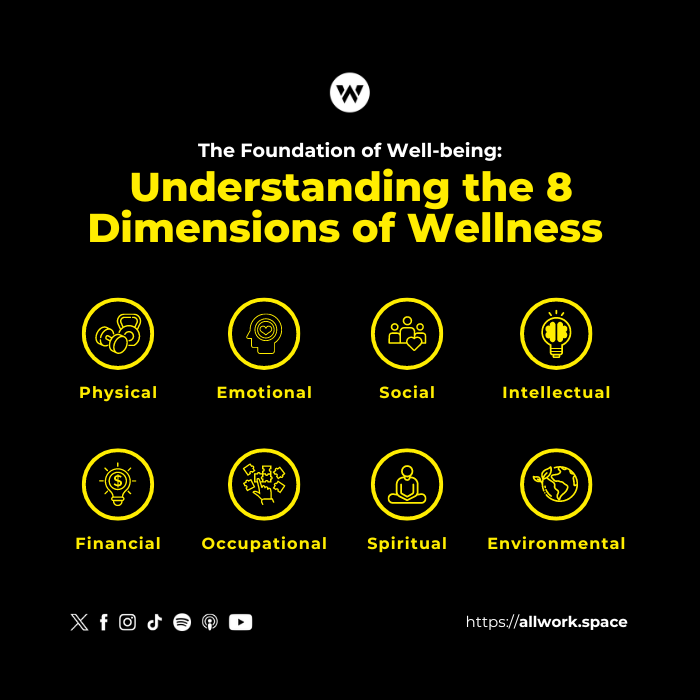- The eight dimensions of wellness offer a comprehensive framework for understanding and improving overall well-being, including in the workplace.
- Neglecting one area of wellness can lead to imbalances, affecting other aspects of wellness.
- Employers who invest in multifaceted wellness programs can see substantial benefits in employee satisfaction and productivity, contributing to a positive work environment and culture.
It’s easy to let the clamor of daily life drown out considerations of our own well-being, but taking a moment to tune into wellness can transform our lives.
Wellness is a fundamental part of human existence — impacting our daily activities and overall happiness. It’s more than just avoiding sickness; it’s about actively pursuing a balanced and rewarding life.
In the pursuit of productivity and financial gain, worker well-being has seemingly been pushed to the backseat. In fact, a global Gallup report shows that only 33% of employees are “thriving” in their wellbeing.
This guide delves into the core of what wellness really means, and explores the eight crucial dimensions as outlined by the wellness wheel: physical, emotional, social, intellectual, environmental, spiritual, occupational, and financial wellness.
By gaining a clear understanding of these areas, workers will see a clear path to maintaining their overall health.
The Foundation of Well-being: Understanding the 8 Dimensions of Wellness
The definition of wellness describes it as an active effort to become aware of and choose actions that lead to a more fulfilling life. This is where the importance of the 8 dimensions of wellness comes in, with each one offering a unique contribution to improving our overall well-being. Consider these eight areas and how each impacts your life:

- Physical Wellness: Maintaining a healthy body is fundamental. This involves regular physical activities, balanced nutrition, adequate rest, and abstaining from harmful habits like excessive drinking or smoking. It’s not just about avoiding disease; it’s about thriving.
- Emotional Wellness: Our emotional state plays a critical role in how we experience life. Emotional wellness is about understanding and respecting your feelings, learning how to express them appropriately, and developing coping strategies for stress and challenging situations. This dimension emphasizes resilience and self-compassion.
- Social Wellness: Humans are inherently social beings. Social wellness focuses on the value of our relationships — fostering deep connections, building a support system, and feeling a sense of belonging within our community. It’s about nurturing positive interactions and understanding our role in society.
- Intellectual Wellness: A stimulated mind is vital for our well-being. Intellectual wellness encourages us to engage in creative and stimulating mental activities. Learning new skills, pursuing hobbies, and indulging in cultural events contribute to this dimension, offering richness and personal growth.
- Environmental Wellness: Our environment affects our health. This dimension involves recognizing our ecological impact and making choices that contribute to a sustainable world. From the spaces where we live and work to global environmental issues, how we care for our surroundings reflects back on our own well-being.
- Spiritual Wellness: This aspect allows us to find meaning beyond the materialistic aspects of life. Whether through religion, meditation, nature, or philosophy, spiritual wellness helps us understand our place in the universe and find a sense of purpose and peace.
- Occupational Wellness: Finding fulfillment in our work significantly impacts our wellness. Occupational wellness is about deriving meaning from our occupations, striving for growth, and balancing our work with other life areas. It encompasses job satisfaction, career development, and personal performance.
- Financial Wellness: Economic stability is more than having sufficient funds; it’s about managing resources wisely, planning for future finances, and living within means. Financial wellness contributes significantly to our stress levels and life satisfaction, underscoring the need for informed budgeting and financial planning.
Interrelation and Contribution to Overall Well-being
The 8 dimensions of wellness do not operate in isolation; each dimension influences and supports the others. The wellness wheel visually represents this interconnectedness, emphasizing balance among all dimensions for optimal health. Neglecting one area can lead to imbalances, affecting other aspects of wellness. For instance, poor physical health can dampen emotional wellness, while financial strain might heighten stress levels, further impacting physical health.
“The core principle behind the wheel of wellness is that balance is key to achieve a state of wellbeing. Since all dimensions of wellness are interconnected, an imbalance in one area can prevent you from living life to the fullest and maintaining a state of wellbeing,” according to an Allwork.Space article.
Wellness in the Workplace: Application and Strategies
The workplace sees a dynamic manifestation of the eight dimensions of wellness. Physical wellness should be promoted through ergonomic spaces and breaks for activity. Emotional and social wellness flourishes in positive cultures with access to mental health resources and team-building activities. Intellectual wellness thrives on continuous learning opportunities, while occupational wellness benefits from career development programs.
Employers play a pivotal role in nurturing these dimensions by implementing comprehensive wellness programs that encompass health screenings, fitness initiatives, flexible schedules, educational seminars, and mental health support. Encouraging a culture of wellness enhances employee satisfaction, reduces absenteeism, and boosts productivity.
Remote Work May Be A Double-Edged Sword
While remote work offers a better work-life balance and reduces commuting stresses, it presents unique challenges across the wellness dimensions. Isolation can impede social and occupational wellness, while blurring work-life boundaries affects emotional and vocational well-being. Employers can mitigate these impacts with strategies fostering regular communication, remote team-building activities, and clear work-hour guidelines.
Balancing Work-Life Harmony and Wellness Maintenance
Maintaining work-life balance is critical in preserving wellness across all dimensions. Setting clear boundaries between professional and personal lives, prioritizing health, and engaging in activities catering to various wellness dimensions are key, and effective communication with employers regarding needs and boundaries further ensures this balance.
Navigating Wellness with the Wellness Wheel
The wellness wheel plays a crucial role in assessing and improving workplace well-being. It serves as a diagnostic tool, helping individuals and organizations identify strengths and areas needing improvement. By offering a visual representation of the interconnected dimensions, it lays the foundation for a balanced approach toward holistic wellness in both personal and professional spheres.
Embarking on a Path to Comprehensive Wellness
Beginning a wellness journey requires a nuanced understanding of the multifaceted nature of well-being. By exploring the 8 dimensions of wellness and employing the wellness wheel as a guide, individuals can steer themselves toward a more balanced, healthy, and fulfilling life.
Employers, too, have a stake in this endeavor, as fostering a workplace environment conducive to wellness pays dividends in employee satisfaction and productivity.


 Dr. Gleb Tsipursky – The Office Whisperer
Dr. Gleb Tsipursky – The Office Whisperer Nirit Cohen – WorkFutures
Nirit Cohen – WorkFutures Angela Howard – Culture Expert
Angela Howard – Culture Expert Drew Jones – Design & Innovation
Drew Jones – Design & Innovation Jonathan Price – CRE & Flex Expert
Jonathan Price – CRE & Flex Expert












